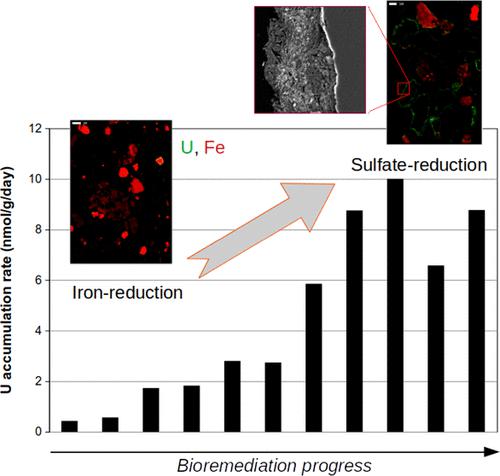当前位置:
X-MOL 学术
›
ACS Earth Space Chem.
›
论文详情
Our official English website, www.x-mol.net, welcomes your feedback! (Note: you will need to create a separate account there.)
Reducing Conditions Influence U(IV) Accumulation in Sediments during In Situ Bioremediation
ACS Earth and Space Chemistry ( IF 3.4 ) Pub Date : 2024-01-26 , DOI: 10.1021/acsearthspacechem.3c00271 Noémie Janot 1 , Sarrah M. Dunham-Cheatham 1 , Juan S. Lezama Pacheco 1 , José M. Cerrato 2 , Daniel S. Alessi 3 , Vincent Noël 1 , Eunmin Lee 2 , Don Q. Pham 1 , Elena Suvorova 3 , Rizlan Bernier-Latmani 3 , Kenneth H. Williams 4 , Philip E. Long 4 , John R. Bargar 1
ACS Earth and Space Chemistry ( IF 3.4 ) Pub Date : 2024-01-26 , DOI: 10.1021/acsearthspacechem.3c00271 Noémie Janot 1 , Sarrah M. Dunham-Cheatham 1 , Juan S. Lezama Pacheco 1 , José M. Cerrato 2 , Daniel S. Alessi 3 , Vincent Noël 1 , Eunmin Lee 2 , Don Q. Pham 1 , Elena Suvorova 3 , Rizlan Bernier-Latmani 3 , Kenneth H. Williams 4 , Philip E. Long 4 , John R. Bargar 1
Affiliation

|
This study presents field experiments conducted in a contaminated aquifer in Rifle, CO, to determine the speciation and accumulation of uranium in sediments during in situ bioreduction. We applied synchrotron-based X-ray spectroscopy and imaging techniques as well as aqueous chemistry measurements to identify changes in U speciation in water and sediment in the first days follwing electron donor amendment. Limited changes in U solid speciation were observed throughout the duration of this study, and non-crystalline U(IV) was identified in all samples obtained. However, U accumulation rates strongly increased during in situ bioreduction, when the dominant microbial regime transitioned from iron- to sulfate-reducing conditions. Results suggest that uranium is enzymatically reduced during Fe reduction, as expected. Mineral grain coatings newly formed during sulfate reduction act as reduction hotspots, where numerous reductants can act as electron donors [Fe(II), S(II), and microbial extracellular polymeric substances] that bind and reduce U. The results have implications for identifying how changes in the dominant reducing mechanism, such as Fe versus sulfate reduction, affect trace metal speciation and accumulation. The outcomes from this study provide additional insights into uranium accumulation mechanisms in sediments that could be useful for the refinement of quantitative models describing redox processes and contaminant dynamics in floodplain aquifers.
中文翻译:

还原条件影响原位生物修复过程中沉积物中 U(IV) 的积累
本研究介绍了在科罗拉多州赖夫尔受污染的含水层中进行的现场实验,以确定原位生物还原过程中沉积物中铀的形态和积累。我们应用基于同步加速器的 X 射线光谱和成像技术以及水化学测量来识别电子供体修正后第一天内水和沉积物中 U 形态的变化。在整个研究期间观察到 U 固体形态的有限变化,并且在获得的所有样品中都鉴定出了非晶体 U(IV)。然而,当主要微生物状态从铁还原条件转变为硫酸盐还原条件时,在原位生物还原过程中, U积累率急剧增加。结果表明,正如预期的那样,铀在铁还原过程中被酶还原。在硫酸盐还原过程中新形成的矿物颗粒涂层充当还原热点,其中许多还原剂可以充当结合并还原 U 的电子供体 [Fe(II)、S(II) 和微生物胞外聚合物]。该结果对于识别主要还原机制的变化(例如铁与硫酸盐还原)如何影响痕量金属形态和积累。这项研究的结果为沉积物中铀积累机制提供了更多见解,这可能有助于完善描述洪泛区含水层氧化还原过程和污染物动态的定量模型。
更新日期:2024-01-26
中文翻译:

还原条件影响原位生物修复过程中沉积物中 U(IV) 的积累
本研究介绍了在科罗拉多州赖夫尔受污染的含水层中进行的现场实验,以确定原位生物还原过程中沉积物中铀的形态和积累。我们应用基于同步加速器的 X 射线光谱和成像技术以及水化学测量来识别电子供体修正后第一天内水和沉积物中 U 形态的变化。在整个研究期间观察到 U 固体形态的有限变化,并且在获得的所有样品中都鉴定出了非晶体 U(IV)。然而,当主要微生物状态从铁还原条件转变为硫酸盐还原条件时,在原位生物还原过程中, U积累率急剧增加。结果表明,正如预期的那样,铀在铁还原过程中被酶还原。在硫酸盐还原过程中新形成的矿物颗粒涂层充当还原热点,其中许多还原剂可以充当结合并还原 U 的电子供体 [Fe(II)、S(II) 和微生物胞外聚合物]。该结果对于识别主要还原机制的变化(例如铁与硫酸盐还原)如何影响痕量金属形态和积累。这项研究的结果为沉积物中铀积累机制提供了更多见解,这可能有助于完善描述洪泛区含水层氧化还原过程和污染物动态的定量模型。



























 京公网安备 11010802027423号
京公网安备 11010802027423号